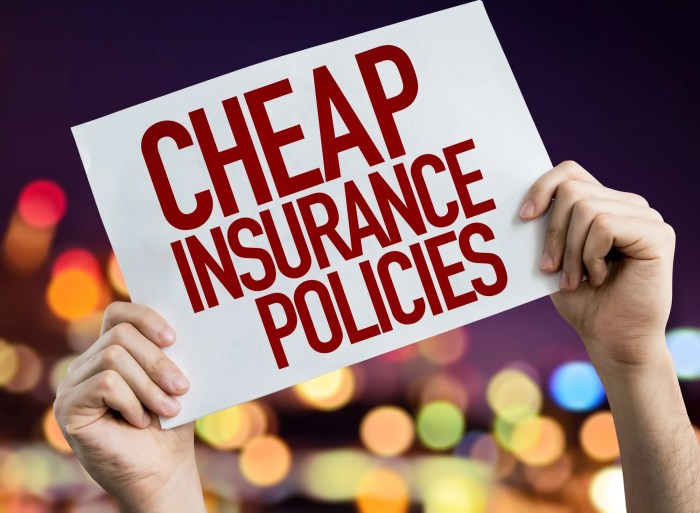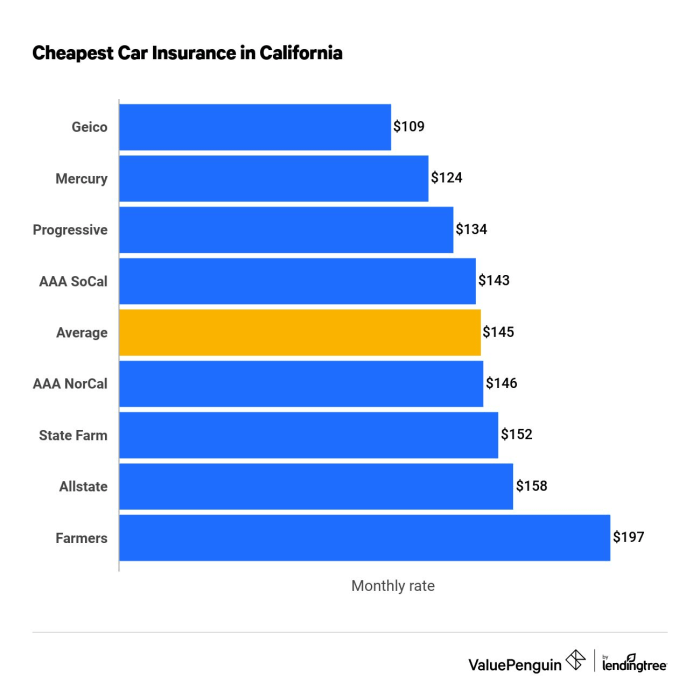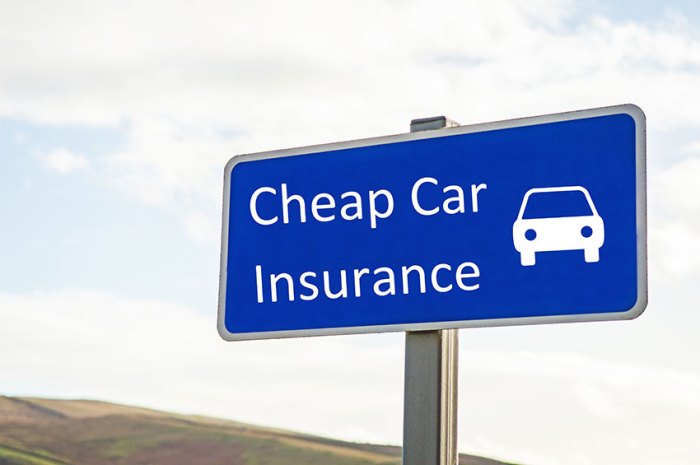The cost of auto insurance can feel like a significant burden, but navigating the complexities of premiums doesn’t have to be daunting. Understanding the factors influencing your rates empowers you to make informed decisions and potentially save a substantial amount of money each year. This guide explores the key elements impacting auto insurance costs, offering practical strategies to find more affordable coverage without compromising essential protection.
From understanding the impact of your driving history and credit score to leveraging discounts and comparing quotes, we’ll equip you with the knowledge to secure cheaper auto insurance that aligns with your needs and budget. We’ll also delve into the intricacies of different coverage options, ensuring you understand exactly what you’re paying for and how to optimize your policy for maximum savings.
Factors Affecting Auto Insurance Costs
Several key factors influence the price you pay for auto insurance. Understanding these factors can help you make informed decisions to potentially lower your premiums. This section will explore the most significant elements that insurance companies consider when calculating your rates.
Driving History
Your driving history is a primary determinant of your insurance cost. A clean driving record, free of accidents and traffic violations, will typically result in lower premiums. Conversely, accidents, particularly those deemed your fault, and traffic violations like speeding tickets or DUIs, significantly increase your insurance rates. The severity of the accident or violation also plays a role; a major accident will have a more substantial impact than a minor fender bender. Insurance companies use a points system to track driving infractions, and more points generally translate to higher premiums. For example, a driver with multiple speeding tickets might see their premiums increase by 20-30% or more compared to a driver with a clean record.
Age and Gender
Age and gender are statistically correlated with accident risk, and insurance companies use this data to set rates. Younger drivers, particularly those under 25, generally pay higher premiums due to their statistically higher accident rates. This is because young drivers often lack experience and may engage in riskier driving behaviors. As drivers age and gain experience, their premiums typically decrease. Gender also plays a role, although this varies by location and insurance company. Historically, male drivers have been statistically associated with higher accident rates than female drivers in certain age groups, which can result in slightly higher premiums for males in some cases.
Car Type
The type of car you drive significantly impacts your insurance cost. Insurance companies consider factors like the vehicle’s make, model, year, safety features, and repair costs. Luxury cars and high-performance vehicles tend to have higher insurance premiums due to their higher repair costs and greater potential for theft. Conversely, smaller, less expensive cars usually have lower insurance premiums. For example, insuring a new luxury SUV will generally be more expensive than insuring a used compact car. Features like anti-theft systems and advanced safety technologies can sometimes lead to lower premiums as they reduce the risk of accidents and theft.
Location
Your location plays a crucial role in determining your insurance rates. Areas with higher crime rates, more traffic congestion, and a greater frequency of accidents typically have higher insurance premiums. Urban areas often have higher rates than rural areas due to these factors. Insurance companies analyze accident statistics and claim frequencies in specific geographic locations to assess risk. Living in a high-risk area can significantly increase your premiums compared to living in a lower-risk area.
Credit Score
In many states, your credit score is a factor in determining your auto insurance premiums. Studies have shown a correlation between credit score and insurance risk, although the exact reasons for this are debated. Individuals with poor credit scores often pay higher premiums than those with good credit scores. This is because individuals with poor credit scores are statistically more likely to file claims. The impact of credit score on insurance rates varies by state and insurance company.
Coverage Levels and Costs
| Coverage Level | Liability (per accident) | Collision | Comprehensive |
|---|---|---|---|
| Minimum Coverage | $25,000/$50,000 | Not Included | Not Included |
| Standard Coverage | $100,000/$300,000 | $500 deductible | $500 deductible |
| Premium Coverage | $500,000/$1,000,000 | $250 deductible | $250 deductible |
| Full Coverage (Example) | $500,000/$1,000,000 | $0 deductible | $0 deductible |
Finding Affordable Auto Insurance

Securing affordable auto insurance is a crucial aspect of responsible car ownership. Finding the right policy involves understanding your options, actively seeking out discounts, and negotiating effectively. This section will guide you through the process of obtaining the most cost-effective auto insurance coverage.
Comparing Auto Insurance Quotes
Effectively comparing auto insurance quotes requires a systematic approach. Begin by obtaining quotes from multiple insurance providers, both large national companies and smaller regional insurers. Use online comparison tools, which allow you to input your information once and receive quotes from several companies simultaneously. Remember to compare not only the price but also the coverage offered. Ensure that the policies you are comparing provide similar levels of liability, collision, and comprehensive coverage. Carefully review the policy details, paying attention to deductibles and exclusions.
Lowering Premiums Through Safe Driving
Maintaining a clean driving record is one of the most significant factors in determining your auto insurance premium. Avoiding accidents and traffic violations demonstrates to insurers that you are a low-risk driver. Consider enrolling in defensive driving courses; many insurers offer discounts for completing such programs. These courses often teach valuable driving techniques that can further reduce your risk of accidents. Consistent safe driving habits translate directly into lower premiums over time.
Commonly Offered Insurance Discounts
Insurance companies offer a variety of discounts to incentivize safe driving and customer loyalty. These discounts can significantly reduce your premium. Common discounts include:
- Good student discounts: For students maintaining a certain GPA.
- Safe driver discounts: For drivers with a clean driving record.
- Multi-car discounts: For insuring multiple vehicles under the same policy.
- Multi-policy discounts: For bundling auto insurance with other types of insurance, such as homeowners or renters insurance.
- Vehicle safety feature discounts: For vehicles equipped with anti-theft devices or advanced safety features.
- Payment plan discounts: For paying your premiums in full or opting for automatic payments.
It’s crucial to inquire about all available discounts when obtaining quotes.
Negotiating Lower Insurance Rates
Negotiating lower insurance rates can sometimes be successful. Start by politely explaining your situation and your commitment to safe driving. Highlight any discounts you qualify for. If you’ve been a loyal customer with a good driving record, this is a strong point to emphasize. Consider shopping around for quotes before renewing your policy; this often provides leverage during negotiations. Remember to be respectful and professional throughout the process.
Switching to a Cheaper Insurance Provider
Switching to a cheaper insurance provider is a straightforward process.
- Obtain quotes from several insurance companies.
- Choose the policy that best suits your needs and budget.
- Notify your current insurer of your intention to cancel your policy.
- Provide your new insurer with the necessary information to initiate coverage.
- Ensure there is no gap in coverage between policies.
- Obtain confirmation of your new coverage.
Resources for Finding Affordable Auto Insurance
Finding affordable auto insurance involves utilizing various resources.
- Online comparison websites: These websites allow you to compare quotes from multiple insurers simultaneously.
- Independent insurance agents: These agents can help you find the best policy for your needs.
- Your state’s insurance department: This department can provide information on consumer rights and insurance regulations.
- Consumer advocacy groups: These groups offer resources and support to consumers seeking affordable insurance.
Bundling and Saving Money

Bundling your insurance policies can be a smart way to save money and simplify your financial life. By combining multiple insurance products with a single provider, you often qualify for significant discounts that wouldn’t be available if you purchased each policy separately. This strategy offers both financial and administrative benefits, making it an attractive option for many consumers.
Many insurance companies offer discounts for bundling auto and homeowners insurance. These discounts can vary widely depending on the insurer, your coverage levels, and your risk profile. The savings often represent a substantial percentage of your overall insurance costs, making it a worthwhile consideration for most people.
Benefits of Bundling Auto and Home Insurance
Bundling your auto and home insurance offers several key advantages. The most significant is the cost savings resulting from the bundled discount. This discount incentivizes customer loyalty and simplifies billing, reducing administrative overhead for the insurance company, which they pass on to the customer. Furthermore, dealing with a single provider for both your auto and home insurance simplifies claims processing and communication. In the event of a claim, having a single point of contact can streamline the process and reduce potential confusion.
Cost Savings Comparison: Bundled vs. Separate Policies
The cost savings associated with bundling can be substantial. For example, let’s consider a hypothetical scenario. A homeowner with a $1,200 annual auto insurance premium and a $1,000 annual home insurance premium might receive a 15% discount when bundling these policies. This translates to a savings of $330 annually ($1,200 + $1,000 = $2,200 x 0.15 = $330). Without bundling, the total annual cost would be $2,200, while the bundled cost would be $1,870. The exact savings will vary depending on the insurer and the specific policies.
Other Bundled Insurance Products
While auto and home insurance are the most common bundled products, many insurers also offer discounts for bundling additional policies. These may include umbrella liability insurance, which provides additional liability coverage beyond your auto and home policies; renters insurance, offering similar protection for renters; and even life insurance in some cases. The availability of these bundled options will vary by insurer.
Factors to Consider When Deciding Whether to Bundle
Before deciding to bundle your insurance policies, consider several factors. Compare quotes from different insurers, both bundled and unbundled, to ensure you’re getting the best value. Analyze your individual needs and risk profile; bundling might not always be the most cost-effective solution if your risk factors differ significantly between your auto and home. Also, examine the level of customer service and claims handling provided by each insurer.
Examples of Companies Offering Bundled Insurance Packages
Numerous major insurance companies offer bundled insurance packages, including State Farm, Allstate, Geico, and Progressive. Each company offers different discounts and policy options, so comparing quotes is essential before making a decision. It is important to note that the specific discounts and available policies may vary by state and individual circumstances.
Bundled vs. Unbundled Insurance Costs
| Policy Type | Unbundled Annual Cost | Bundled Annual Cost | Savings |
|---|---|---|---|
| Auto Insurance | $1200 | $1000 | $200 |
| Homeowners Insurance | $1000 | $800 | $200 |
| Total | $2200 | $1800 | $400 |
Ending Remarks

Securing cheaper auto insurance is achievable with careful planning and a strategic approach. By understanding the factors influencing your premiums, actively comparing quotes, and negotiating effectively, you can significantly reduce your insurance costs without sacrificing the crucial protection you need. Remember, proactive engagement and informed decision-making are key to navigating the world of auto insurance and achieving substantial savings.
Clarifying Questions
What is the best time of year to buy auto insurance?
There’s no single “best” time, but shopping around closer to your renewal date allows for direct comparison with your current policy.
Can I get cheaper insurance with a telematics device?
Yes, many insurers offer discounts for using telematics devices that track your driving habits. Good driving behavior often translates to lower premiums.
How often should I review my auto insurance policy?
At least annually, or whenever significant life changes occur (new car, address change, etc.). Your needs and risk profile may change, requiring policy adjustments.
What if I have a lapse in my auto insurance coverage?
A lapse can significantly increase future premiums. Maintain continuous coverage to avoid higher rates.